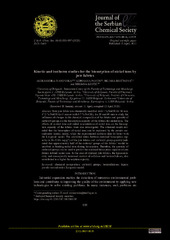Kinetic and isotherm studies for the biosorption of nickel ions by jute fabrics
Чланак у часопису (Објављена верзија)
Метаподаци
Приказ свих података о документуАпстракт
Raw jute fabric was chemically modified with 1 % NaOH for 30 min, 17.5 % NaOH for 5 min or with 0.7 % NaClO2 for 30 and 60 min to study the influence of changes in the chemical composition of the fabrics and quantity of carboxyl groups on the biosorption capacity of the fabrics for nickel ions. The effects of contact time and initial concentration of nickel ions on the biosorption capacity of the fabrics were also investigated. The obtained results revealed that the biosorption of nickel ions can be explained by the pseudo-second-order kinetic model, while the experimental isotherm data fit better with the Langmuir model. The calculated ratios between maximal biosorption capacity (6.30-12.06 mg g(-1)) of the jute fabrics and carboxyl group quantity indicated that approximately half of the carboxyl groups of the fabrics' would be involved in binding nickel ions during biosorption. Therefore, the quantity of carboxyl groups can be used to predict the maximal biosorption capacity of jute ...fabrics toward nickel ions. In the case of oxidized jute fabrics, the lignin removal, and consequently increased content of cellulose and hemicelluloses, also contributed to a higher biosorption capacity.
Кључне речи:
chemical composition / carboxyl groups / hemicelluloses / lignin / pseudo-second-order / Langmuir modelИзвор:
Journal of the Serbian Chemical Society, 2021, 86, 9, 885-897Финансирање / пројекти:
- Министарство науке, технолошког развоја и иновација Републике Србије, институционално финансирање - 200135 (Универзитет у Београду, Технолошко-металуршки факултет) (RS-MESTD-inst-2020-200135)
- Министарство науке, технолошког развоја и иновација Републике Србије, институционално финансирање - 200287 (Иновациони центар Технолошко-металуршког факултета у Београду доо) (RS-MESTD-inst-2020-200287)
DOI: 10.2298/JSC210209030I
ISSN: 0352-5139
WoS: 000692558700009
Scopus: 2-s2.0-85114222598
Колекције
Институција/група
Inovacioni centarTY - JOUR AU - Ivanovska, Aleksandra AU - Pavun, Leposava AU - Dojčinović, Biljana AU - Kostić, Mirjana PY - 2021 UR - http://TechnoRep.tmf.bg.ac.rs/handle/123456789/4810 AB - Raw jute fabric was chemically modified with 1 % NaOH for 30 min, 17.5 % NaOH for 5 min or with 0.7 % NaClO2 for 30 and 60 min to study the influence of changes in the chemical composition of the fabrics and quantity of carboxyl groups on the biosorption capacity of the fabrics for nickel ions. The effects of contact time and initial concentration of nickel ions on the biosorption capacity of the fabrics were also investigated. The obtained results revealed that the biosorption of nickel ions can be explained by the pseudo-second-order kinetic model, while the experimental isotherm data fit better with the Langmuir model. The calculated ratios between maximal biosorption capacity (6.30-12.06 mg g(-1)) of the jute fabrics and carboxyl group quantity indicated that approximately half of the carboxyl groups of the fabrics' would be involved in binding nickel ions during biosorption. Therefore, the quantity of carboxyl groups can be used to predict the maximal biosorption capacity of jute fabrics toward nickel ions. In the case of oxidized jute fabrics, the lignin removal, and consequently increased content of cellulose and hemicelluloses, also contributed to a higher biosorption capacity. T2 - Journal of the Serbian Chemical Society T1 - Kinetic and isotherm studies for the biosorption of nickel ions by jute fabrics EP - 897 IS - 9 SP - 885 VL - 86 DO - 10.2298/JSC210209030I ER -
@article{
author = "Ivanovska, Aleksandra and Pavun, Leposava and Dojčinović, Biljana and Kostić, Mirjana",
year = "2021",
abstract = "Raw jute fabric was chemically modified with 1 % NaOH for 30 min, 17.5 % NaOH for 5 min or with 0.7 % NaClO2 for 30 and 60 min to study the influence of changes in the chemical composition of the fabrics and quantity of carboxyl groups on the biosorption capacity of the fabrics for nickel ions. The effects of contact time and initial concentration of nickel ions on the biosorption capacity of the fabrics were also investigated. The obtained results revealed that the biosorption of nickel ions can be explained by the pseudo-second-order kinetic model, while the experimental isotherm data fit better with the Langmuir model. The calculated ratios between maximal biosorption capacity (6.30-12.06 mg g(-1)) of the jute fabrics and carboxyl group quantity indicated that approximately half of the carboxyl groups of the fabrics' would be involved in binding nickel ions during biosorption. Therefore, the quantity of carboxyl groups can be used to predict the maximal biosorption capacity of jute fabrics toward nickel ions. In the case of oxidized jute fabrics, the lignin removal, and consequently increased content of cellulose and hemicelluloses, also contributed to a higher biosorption capacity.",
journal = "Journal of the Serbian Chemical Society",
title = "Kinetic and isotherm studies for the biosorption of nickel ions by jute fabrics",
pages = "897-885",
number = "9",
volume = "86",
doi = "10.2298/JSC210209030I"
}
Ivanovska, A., Pavun, L., Dojčinović, B.,& Kostić, M.. (2021). Kinetic and isotherm studies for the biosorption of nickel ions by jute fabrics. in Journal of the Serbian Chemical Society, 86(9), 885-897. https://doi.org/10.2298/JSC210209030I
Ivanovska A, Pavun L, Dojčinović B, Kostić M. Kinetic and isotherm studies for the biosorption of nickel ions by jute fabrics. in Journal of the Serbian Chemical Society. 2021;86(9):885-897. doi:10.2298/JSC210209030I .
Ivanovska, Aleksandra, Pavun, Leposava, Dojčinović, Biljana, Kostić, Mirjana, "Kinetic and isotherm studies for the biosorption of nickel ions by jute fabrics" in Journal of the Serbian Chemical Society, 86, no. 9 (2021):885-897, https://doi.org/10.2298/JSC210209030I . .



